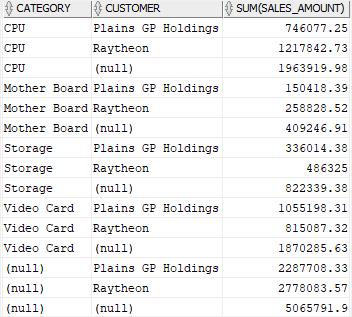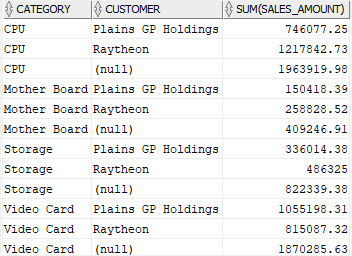Summary: in this tutorial, you will learn how to use the Oracle CUBE to generate grouping sets for all possible combinations of dimensions.
Introduction to Oracle CUBE expression
The CUBE is an extension of the GROUP BY clause that allows you to generate grouping sets for all possible combinations of dimensions.
The following illustrates the basic syntax of the CUBE with three columns (or dimensions):
SELECT c1, c2, c3, aggregate(c4)
FROM table_name
GROUP BY CUBE(c1,c2,c3);
Code language: SQL (Structured Query Language) (sql)In this syntax, the c1, c2, and c3 columns are called dimensions. The result of the aggregate(c4) aggregate function is known as a fact.
Typically, a fact is a number e.g., the sales amount. A dimension gives the fact a business context. For example, the product category and customer columns are dimensions that describe the sales amount such as total sales amount by product category and total sales amount by the customer.
The CUBE generates grouping sets of all combinations of c1, c2 and c3 dimensions, which returns 8 grouping sets.
In general, if you have n columns specified in the CUBE, you will get 2n grouping sets.
When the aggregate function is the SUM() function, you will have 2n subtotals for all the possible combinations of dimensions.
Oracle CUBE examples
See the following customer_category_sales view that returns sales amounts for all product categories and customers with the identity of 1 and 2:
CREATE OR ALTER VIEW customer_category_sales AS
SELECT
category_name category,
customers.name customer,
SUM(quantity*unit_price) sales_amount
FROM
orders
INNER JOIN customers USING(customer_id)
INNER JOIN order_items USING (order_id)
INNER JOIN products USING (product_id)
INNER JOIN product_categories USING (category_id)
WHERE
customer_id IN (1,2)
GROUP BY
category_name,
customers.name;
Code language: SQL (Structured Query Language) (sql)This example uses the CUBE to generate subtotals for product category and customer and grand total for these customers (customer id 1 and 2) and all product categories:
SELECT
category,
customer,
SUM(sales_amount)
FROM
customer_category_sales
GROUP BY
CUBE(category,customer)
ORDER BY
category NULLS LAST,
customer NULLS LAST;
Code language: SQL (Structured Query Language) (sql)Here is the output:

In this example, we have two dimensions: category and customer, therefore, the statement returns 4 subtotals:
- A subtotal by category.
- A subtotal by customer.
- A subtotal by both category and customer.
- A grand total.
Oracle allows you to reduce the number of generated grouping sets by using a partial cube as shown in the following syntax:
SELECT c1, c2, c3, aggregate(c4)
FROM table_name
GROUP BY c1, CUBE(c2,c3);
Code language: SQL (Structured Query Language) (sql)In this case, you will get 4 instead of 8 grouping sets.
For example, the following query uses a partial cube that generates subtotals for the product category dimension only:
SELECT
category,
customer,
SUM(sales_amount)
FROM
customer_category_sales
GROUP BY
category,
CUBE(customer)
ORDER BY
category,
customer NULLS LAST;
Code language: SQL (Structured Query Language) (sql)Here is the output:

In this tutorial, you have learned how to use the Oracle CUBE to generate grouping sets for all possible combinations of dimensions.